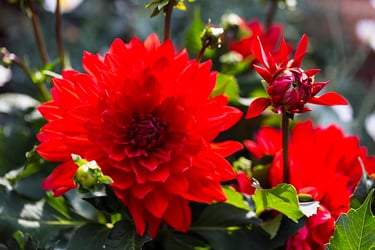Spring Flowers and Trees for Sale - Buying & Growing Guide
Do You Know Your Growing Zone? i Growing zones help determine if a particular plant is likely to grow well in a location. It identifies the average annual minimum winter temperatures across the U.S. provided as a map by the USDA.
11 Results
Spring Flowers and Trees – Buying & Growing Guide
Flowers that signal the start of spring are some of the most welcome additions to any garden. But if you want a landscape full of blooms as soon as the weather gets warm, you need to know which species to pick and how to care for them well. With that knowledge, you can expect vibrant petals to fill your garden when spring arrives.
Types of Spring Flowers and Trees
| Type | Growing Zones | Mature Height | Harvest Season | Sun | Features |
| Flowering dogwood, Cornus florida | 5-9 | 15-30 feet | August to September | Full sun to part shade: 4-8 hours | Impressive spring flower, attractive branching habit, and admirable fall color |
| Flowering crabapple, Malus ‘Sutyzam’ SUGAR TYME | 4-8 | 14-18 feet | None | Full sun: 6-8 hours | Great flowering tree, moderate size |
| Serviceberry,
Amelanchier canadensis |
4-8 | 25-30 feet | June to July | Full sun to part shade: 4-8 hours | Early season flowers are white, and form is quite graceful |
| Eastern redbud, Cercis canadensis | 4-8 | 20-30 feet | None | Full sun to part shade: 4-8 hours | Large heart-shaped leaves, vibrant purple flowers in spring |
| Cornelian cherry dogwood, Cornus mas | 4-8 | 15-25 feet | None | Full sun to part shade: 4-8 hours | Early spring flowers rival forsythia |
| Callery pear tree, Pyrus calleryana ‘Bradford’ | 5-9 | 30-50 feet | None | Full sun: 6-8 hours | Rounded upright growth habit, copious white flowers |
| Daffodil, Narcissus | 3-8 | 6-12 inches | None | Full sun: 6-8 hours | Well-know white or yellow early spring flowers |
| Iris, Iris germanica | 3-10 | 2-3 feet | None | Full sun to part shade: 4-8 hours | Flat, upright foliage with large, showy flowers |
| Tulip, Tulipa | 3-8 | 12-24 inches | None | Full sun: 6-8 hours | Long stems hold large overlapping flower petals |
| Crocus, Crocus | 3-8 | 6-8 inches | None | Full sun to part shade: 4-8 hours | Dense-planting produces a flowery carpet-like effect, blooms very early |
How to Foster Beautiful Spring Blooms
For you to have astounding flowers in your yard, you first need some basic plant care skills. When planting flowering plants, ensure that you give them the sunlight, water, and nutrients that they need to flourish. Since flowering plants come in many varieties, they also come with about as many different care requirements.
After you meet the basic needs of the species you intend to grow, you can focus on maximizing their flower production. Having nutrient-rich soil is a great starting point, but you may also need to follow a regular fertilization schedule to promote the best blooms.
Pruning is also an essential task for anyone who wants to foster beautiful spring blooms. It is generally best to remove spent flowers and other dead or damaged parts of the plant. Removing flowers after they fade is one of the most reliable ways to stimulate future blossoms.
Additionally, while some flowering plants will do well in the shade, most prefer to receive plenty of sunlight. So if your flowering species are not blooming as much as you like, try moving them to a sunnier location. Beyond that, providing a healthy layer of mulch is another fantastic way to help your flowers by allowing the soil to maintain a proper moisture level and temperature.













